THURSDAY
JANUARY 31 - 2019
Colour-ringed
Godwits
Pete Potts
replied to my query about the colour-ringed
Black-tailed Godwit WY+YX seen and photographed
by Peter Milinets-Raby at Langstone yesterday.

Pete confirmed that
this Godwit was ringed in Iceland in 2003 by a small
UK team including Ruth Potts (Pete's mother) and Ruth
Croger from B Waltham on a trip he organised. Pete
agrees it is a good age and is still doing just fine.
He saws it himself at Pulborough earlier this winter.
However, it still has some way to go to beat the 22 or
23 year old colour-ringed godwit that was seen on the
Ouse Washes recently. Pete has asked his colleague in
Iceland (Boddi) to send a revised history of the bird
which will be interesting.
Pete also sent the
history of the other colour-ringed Black-tailed
Godwit R+GR that Peter Milinets-Raby saw yesterday
at Langstone. Pete has 60 records of this bird since
it was first ringed on 05-Sep-2010 by the Farlington
Ringing Group at Farlington Marshes.

Hayling
Oysterbeds
Christopher
Evans had a walk to the Hayling Oysterbeds this
morning and got some fine bird images from the car
park opposite the large garage south of the bridge
which we used to call 'Texaco bay', though I think the
garage has changed its name. This bay is always a good
spot to see Black-tailed Godwits feeding on the
mudflats - my favourite wader.

Christopher's photo
includes a colour-ringed bird Y+LR
which I will pass onto Pete Potts who probably ringed
it at Farlington Marshes.

Curlew and male
Wigeon
Christopher also
snapped this wintering Chiffchaff yesterday at the
northern end of Southmoor.
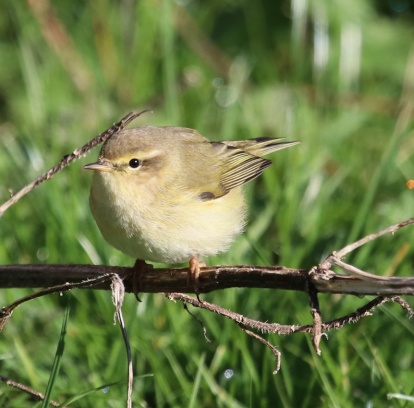
WEDNESDAY
JANUARY 30 - 2019
Langstone
Mill Pond
Peter
Milinets-Raby visited Langstone Mill Pond this morning
from 9:09am to 10:35am - tide going out. Another
freezing morning, -5C, but again another still day, so
the cold felt bearable.
Langstone Mill Pond (two thirds frozen): 1 Canada
Goose, 56 Teal - lots of calls and displaying, a very
pleasant sight.
Off shore: 106 Shelduck (A new January maximum count,
three short of that record count of 109 in December
last year). Male Shoveler again, like yesterday,
feeding along the tide line by the Hayling bridge. 532
Dunlin (This is an above average count, but still 300+
short of being significant). 2 Greenshank (one of them
being the usual semi-resident G//R + BR//-), 11 Grey
Plover,
16 Black-tailed Godwit including two colour-ringed
birds (see below). In the distance off Conigar Point
were another 15 Shelduck and 4 Pintail.
Brian's
note on Black-tailed Godwits
Peter had two colour-ringed Black-tailed
Godwits.
WY+YX - The X ring on the right leg is a white
ring with a black X.

Peter had one previous
sighting of this bird back in Oct 2015. According to
my records this bird was originally ringed as an adult
male in Iceland on 20.4.03 and I have got 9 other
sightings since then, mostly Langstone and Farlington.
If this is the same bird then it must be at least 17
years of age. I will check this with Pete Potts.
R//R+GR - My
records for this bird go back to Mar-2011 with 6
sightings since then including 3 others from Peter. I
don't have the ringing details.

Birders
at Langstone
Peter
commented that there were lots of birders in the
Langstone area this morning. "I've never seen so many
wandering around aimlessly not looking at anything,
just focusing on finding that reported scarcity, not
really appreciating their surroundings and the myriad
of birds on show!! If this is modern twitching, then
what a sad state of affairs the birding world is in?
Ahh, with age comes wisdom. To think exactly 30 years
ago I was skipping off work to travel to Kent to see a
Golden-winged Warbler! Those days are long in the
past! All this birder activity was apparently due to a
reported Smew and Red-necked Grebe from yesterday. I
digress and its time to get off my
soapbox!"
TUESDAY
JANUARY 29 - 2019
Warblington
shore
Peter
Milinets-Raby wandered around the Warblington shore
this morning looking for birds from 9am to 12:30pm -
low tide throughout. He says, despite it being -3C it
wasn't really that cold. It was a 'southern softie
sort of frost', no bite to it what so ever!!
Cemetery: 4 Song Thrush, 1 Great Spotted
Woodpecker.
Ibis Field: 2 Moorhen, 1 Oystercatcher, 1 Grey
Wagtail.
The big stubble field to the east: 27 Skylark, 1 male
Pheasant, 1 Buzzard, 2 Roe Deer, 2 Pied Wagtails, 1
Grey Wagtail, 4 Song Thrush and 1 Meadow Pipit on the
rotting mound of hay. 13 Lapwing flying over north
inland
Conigar Point: 1 Lapwing, 44 Wigeon, 105 Teal (A new
January maximum for Conigar Point), 7 male & 6
female Pintail (an increase in numbers and a new
January maximum for Conigar Point), 77 Brent Geese, 7
Grey Plover, 20 Shelduck, 21 Dunlin, 2 Great
Black-backed Gull.
Off Pook Lane: Two flocks of Lapwing moving inland (47
& 21) with a further 32 on the muddy shore. 60
Shelduck, 96 Brent Geese, 65 Wigeon,
2 Cattle Egret and 2 Little Egret (see photos) in the
field west of the cemetery with a single Lapwing and 4
Redwing over.
1 male Shoveler
feeding along the tide line by the main Hayling
bridge. 23 Black-tailed Godwit (B//R + LG//- Just the
one previous sighting in April 2018). 328 Dunlin, 1
Greenshank, 2 Turnstone, 16 Grey Plover, 105 Teal, 3
Red Breasted Merganser, 3 Common Gull.
Horse paddock: 3 Moorhen, 3 Stock Dove, Sleeping
Fox.
Langstone Mill Pond (half frozen): 1 Water Rail flew
across from one patch of reeds to another, 4 Teal, 1
Canada Goose, 2 Mute Swan,
Herons: Nest 8: 2 adults fiddling with sticks on their
old nest. Nest 4: Adult stood on nest. Nest 5: Adult
stood on nest. I assume that the Heron is still
sitting on eggs on Nest 1 - just not visible!!! There
were two other adults loitering in a nearby
tree.
MONDAY
JANUARY 28 - 2019
Light-bellied
Brent Goose
Peter
Milinets-Raby went birdwatching in Emsworth Harbour
this morning. Starting at Beacon Square he
systematically counted through the Brent Geese and the
49th bird he counted was the smart looking
Light-bellied Brent Goose that Andy Johnson had
previously discovered in Emsworth on Jan 24.
Peter's
photos of the Light-bellied Brent Goose

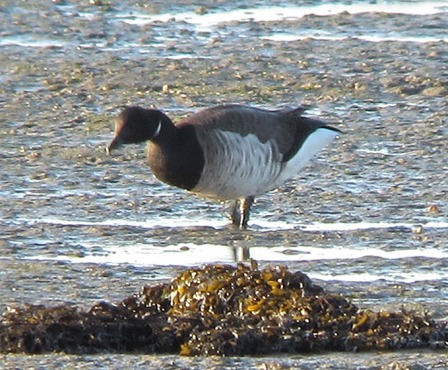
Andy Johnson's photo
of the bird is on GoingBirding at . . .
https://www.goingbirding.co.uk/hants/show_photo.asp?speciestype=2&date1=1900%2D01%2D01&date2=1900%2D01%2D01&includesensitive=False&photo_id=10344
Brian's
note on Light-bellied Brent Geese
As the name suggests Light-bellied Brent Geese
differ from the common Dark-bellied Brent Geese mainly
in their very pale flanks, giving a sharp contrast
with the black breast. Peter's first photo shows the
differences very well, though in my experience the
differences in the field are often not as clear cut as
they are in this case as the flanks of Dark-bellied
Brents vary a lot in lightness.
Light-bellied Brent Geese are scarce winter visitors
to Hampshire, with usually not more than 20 being seen
over the winter period. This compares with 10,000 or
so Dark-bellied Brents.
There are three separate populations of Light-bellied
Brents: (1) breeds arctic Canada and winters Atlantic
coast of USA, (2) breeds eastern arctic Canada and
northern Greenland and winters mainly in Ireland, (3)
breeds Svalbard and winters Denmark and NE England. I
think here in the South of England we tend to get
overshoots from the second population. In contrast,
the Dark-bellied Brent Geese breed in arctic
north-central Siberia, principally the Taymyr
Peninsula and winter throughout Western Europe from
Denmark to France including Southern England.
Other
observations:
Other birds of note that Peter found were as follows:
(Low tide - 9am to 10:55am)
Beacon Square: 189 Brent Geese, 2 Shelduck, 22 Wigeon,
3 Black-tailed Godwit, 4 Grey Plover, 8 Dunlin, a pair
of Pintail.
Nore Barn: Dog
disturbance flushed the 90+ flock of Black-tailed
Godwit and they flew east and were almost certainly
the birds I encountered in Emsworth Harbour off the
mill pond wall later on. 12 male and 8 female Pintail
(a good increase!). Nothing else to count as it had
all been flushed!!!
Emsworth Harbour:
(packed with birds, with 200+ gulls, 2 Little Egrets,
5+ Curlew, 20+ Redshank & 30+ Oystercatchers), 383
Brent Geese, 40 Mute Swans with two extra on the pond
(numbers are still growing - I noted none on the
Bosham Creek yesterday???). 1 Lesser Black-backed
Gull, 1 Great Black-backed Gull, 112 resting
Black-tailed Godwit (almost certainly the disturbed
Nore Barn bunch), 6 Lapwing, 1 Greenshank, 14 Grey
Plover, 26 Teal, 2 Gadwall, 44 Coot, 32 Dunlin,
Surprisingly just 1 Turnstone, 2 Little Grebes, 26
Shelduck, 5 Red Breasted Merganser.
Mill Pond: Mini
motorised yacht races disturbing the pond. Could only
find 14 Coot, BUT in the southern section of the pond,
I had great views of a male Kingfisher perched on a
window sill overlooking the pond.

Other
local news
Christopher
Evans made the most of today's glorious weather and
was out for several hours. Here are his photos from
the day.
The female Kingfisher
was in the culvert that drains the flooded field at
the top of Hayling. The remaining photos were taken
this afternoon at Thornham Point. The Peregrine, which
was spotted by fellow birder John, was on an exposed
mudflat out in the harbour, some way off shore. The
fox was in a slightly different spot to usual and I
had spotted a newly dead fox when I was there
yesterday. The Short Eared Owl appeared shortly after
I'd seen the fox and initially landed on the fence not
far from where I was standing before flying off,
landing on the ground, then after a few minutes flying
off again and disappearing out of sight.
SUNDAY
JANUARY 27 - 2019
Dead
Little Egret
Looking over
the back garden wall this morning I was saddened to
see a Little Egret lying dead in the shallow water of
the stream. A Little Egret has been a regular visitor
to our garden for several years as it perched on the
wall or the fence at the end of the garden looking for
small fish in the stream that flows down to the town
millpond. If, as I assume, this dead bird is actually
our regular visitor, then I shall miss its visits,
though maybe another of its species will in time
discover this rich feeding area and grace us with its
presence.
A view looking
north up the Westbrook Stream from my garden wall
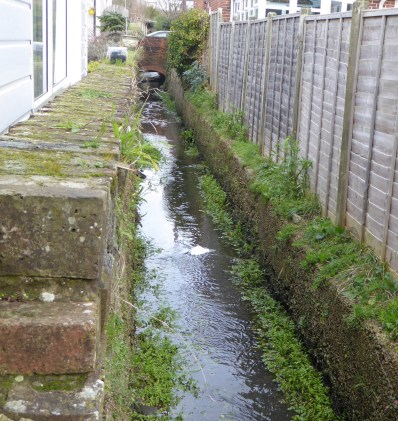
Close-up of the dead
Little Egret
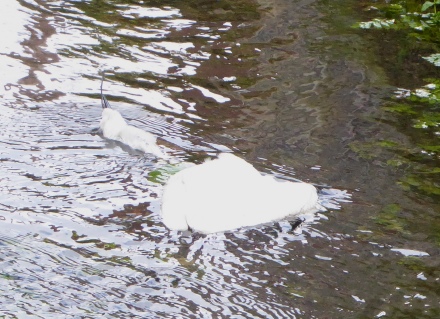
I don't recall having
seen a dead Little Egret anywhere else before. I
wonder how this one died. Natural causes is likely,
though these birds have quite a long lifespan; the
maximum recorded age for a Little Egret in the wild is
22.3 years. Alternatively, it could have been killed
though that seems unlikely in this residential area.
Large water birds are more vulnerable in open public
spaces, Swans and Geese being the most common victims.
However, I did find one recent report for 25/01/2019
that the RSPB was alerted after two dead Little Egrets
were discovered in the River Wandle in London. The
bodies were examined by a vet who thought the injuries
were consistent with catapult wounds.
Hermitage
Millponds
I had a walk
down to the Hermitage Millponds this afternoon, well
wrapped up against the strong northerly winds. In
fact, it was not as bad as I expected, very windy, but
not too cold. The sluice gates were open on Slipper
Millpond which meant the two ponds were empty of
water. Here is a view looking north across Slipper
Millpond.

The coral-like
encrustations created by tube worms are clearly
visible
 .
.
Interestingly, I
discovered a pair of Greenshank busily feeding
in the low water channel on Peter Pond - a most
unusual occurrence.

One of the Greenshank
was colour-ringed - G+BL. This is one of the
Greenshank that originally had a geo tag. I first
recorded it in Emsworth on 09-Apr-14 and it has been
fairly regular here since then.

SATURDAY
JANUARY 26 - 2019
Garden
birds
I regularly
see two Robins in the garden which I assume are a
male-female pair as they seem friendly. However, today
I spotted this rather battle-scarred Robin, which
presumably came off worst in a fight over territory
with a neighbouring male.

This is a reminder
that our friendly sweet Christmas Robin has a pretty
tough existence in the wild. Unlike other common
birds, male Robins aggressively protect their
territory all year round. Here is a stark photo of a
of Robins fighting that I found on the internet.
Scary!
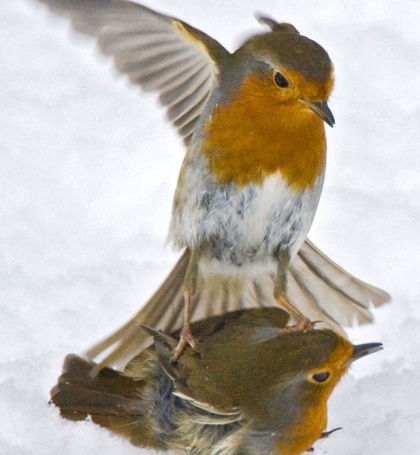
Chris Oakley had a
pleasant surprise this afternoon when he had a visit
from a female Bullfinch to his north Emsworth
garden. This was a first for Chris's garden. Nice one.
Wish one would come my way.

Friends
of Nore Barn Woods
As a paid-up
member, I was interested to receive the latest
Newsletter (Jan 2019) of the Nore Barn Woods group.
This has details of their conservation work in
planting new hedges and managing the woods. How good
it is to hear that this small but intensively used
woodland is in such good hands. Here is a workday team
in Jan 2019.
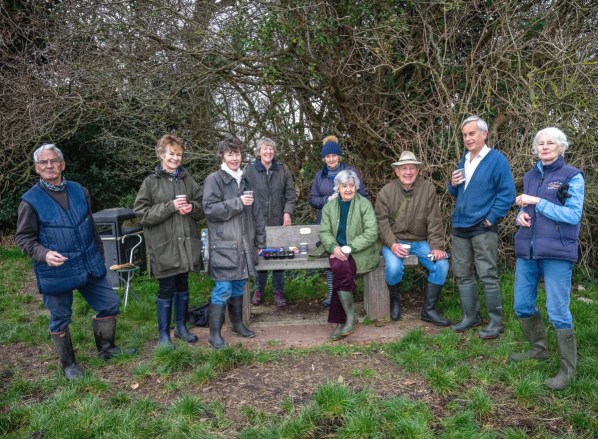
For further
information contact Roy Ewing on 01243 370705 or visit
their website: http://www.norebarnwoods.org.uk
FRIDAY
JANUARY 25 - 2019
Garden
birds
A Stock Dove
was a relatively unusual visitor to the garden today,
the first I have seen for several weeks. In fact, for
a short period today there were 4 species of
dove/pigeon on the grass, Woodpigeon, Collared Dove,
Stock Dove and White Dove.

Green
Sandpiper
Yesterday, as
Jo Bray walked from Westbourne to Emsworth along Mill
Lane towards Lumley Mill she saw a bird flying along
and landing at the edge of the river. She thought it
looked like a Common Sandpiper with a distinctive
white breast and was bobbing up and down when it
landed.
I agree it might have been Common Sandpiper, as a few
do hang around in winter near the coast, but my guess
is Green Sandpiper which is far more regular in winter
and which I often used to see along the River Ems
north of Emsworth in my surveys 10-20 years ago. It
has a distinctive white rump on take off. Snipe were
also regular. That's good if they are still around,
though the river is not easily accessible now. Here is
a nice shot that Richard Somerscocks got of one a few
years ago.

THURSDAY
JANUARY 24 - 2019
Emsworth
walk
I had a very
pleasant walk around the town millpond on this cold
and crisp winter's morning. The pond was largely
frozen with all ducks and coots assembled in the
northern part. I saw one male Tufted Duck on my way
round, the first of the winter, but it was gone when I
returned. The regular assembly of Black-headed Gulls
was standing on the ice, their legs clearly well
insulated against the cold.

Looking back towards
the town
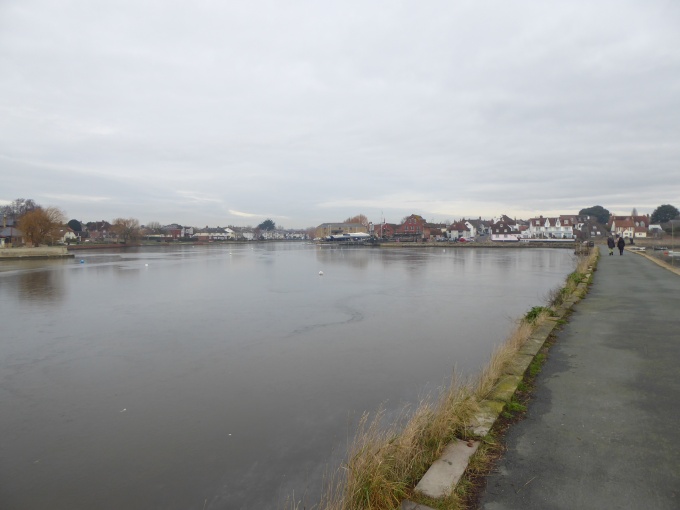
It warmed my heart to
see a troupe of young children from the Bath Road
nursery school braving the chilly weather on the
promenade with their carers. Future birdwatchers,
hopefully!

Meanwhile, out in the
harbour I counted no less than 30 Mute Swans, which is
an exceptional number, a bit like the good old days
when we used to have over 100 on the millpond.

Also in the harbour,
swimming near the seawall, was a small flock of 10
Brent Geese including a family of 2 adults and 2
juveniles. I suspect their breeding season has not
been a good one.

On the way home I
stopped to listen to a Dunnock singing its pretty
little ditty from the bushes in Bridge Road car park -
my first Dunnock song of the year.

TUESDAY
JANUARY 22 - 2019
Warblington
Peter
Milinets-Raby had a quick wander around the
Warblington area this morning for an hour from 9am.
Again, a bit late for the tide, as the tide pushed in
to high very quickly. His report follows . . .
The bird of the
morning was seen along Pook Lane, flying low over the
car with something in its mouth. A very big looking
Raven. It landed on the gnarled half dead tree in
the field north of the black barn, where it perched
just long enough for me to grab a few photos before it
flew off north west.
What ever was in its
mouth was swallowed whole and I suspect it flew off to
go to a nest site (as I have heard from other birders
and from Going Birding that a Raven has been reported
in this area over the last three weeks). I actually
have a pylon in mind and will check over the next few
days.
Other birds seen
were:
Ibis Field: 6 Redwing, 2 Moorhen, 1 Oystercatcher, 1
Song Thrush, 4 Pheasant, 1 Little Egret with the
cattle.
Conigar Point: 137
Wigeon (A good count. A shame it was not done
yesterday, but one can assume the area has over 400+
Wigeon - impressive!!). 25 Teal, 283 Brent Geese, 2
male and 1 female Pintail, 21 Shelduck, 2 male and 1
female Goldeneye.
Off Pook Lane: Only
had time to count the Wigeon (42) before a lady and
her dog walked passed me looking through my scope and
let the dog run along the tide line and chase off ever
little feeding flock of Brent, Wigeon, Teal and
Oystercatchers. Utterly reckless and oblivious to what
her dog was doing!!! More education needed!!!! 1 Seal
seen popping its head above the water a couple of
times. 22 Lapwing. And 4 Little Egrets and 2 Cattle
Egrets in the field west of the cemetery (at last the
farmer has his herd grazing in this
field!!!).
MONDAY
JANUARY 21 - 2019
The
'Blood Moon'
Peter
Milinets-Raby reports a wonderful experience of seeing
the Blood Moon early this morning and got this
cracking image of it. That is so beautiful. I was also
up at 5am to see the moon, but it did not look this
good from my house. Did anyone else see and photograph
this interesting phenomenon?

Emsworth
Harbour
Later in the
morning Peter went for a wander around Emsworth
Harbour from 9am to 10am (Just timed too late as the
tide was nearly in!).
Beacon Square: 5 Canada Geese, 30 Teal, 11 Wigeon, 149
Brent Geese, 187 Dunlin on the last bit off mud, 1
Grey Plover, 6 Turnstone.
Nore Barn: I counted the Wigeon (248 - The third
highest count I have had for Nore Barn, so quite
impressive), then everything departed including a
flock of 80+ Black-tailed Godwits, so I didn't manage
to count anything else. Of note were 5 male Pintail
(did not have the chance to count the females) and THE
Spotted Redshank.
Emsworth Harbour,
looking very photogenic
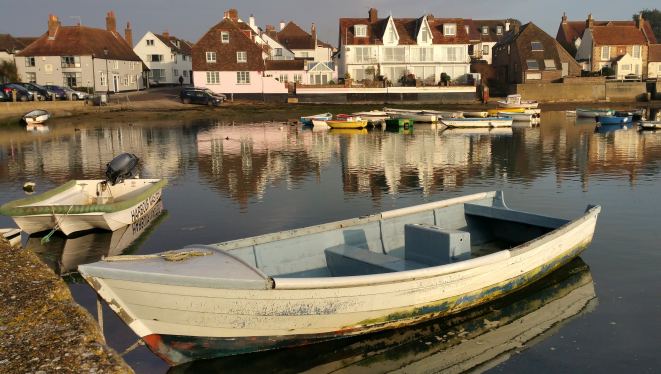
50 Coot, 12 Teal, 4
Lapwing, 9 Little Grebe, 24 Mute Swans (The best count
for ages!!!!) excludes the TWO on the pond, 10 Brent
Geese.
Mill Pond: Over 75% frozen over with 100+ gulls
resting on the ice, roosting Black-headed, with 5+
Common Gulls and 10+ Herring Gulls. 25 Coot
1 Kingfisher perched on the underside of the Start Hut
on the south of the pond fishing in the ice free
puddle under the hut. Some great views!
Greenshank
RG+BY
I walked round
the town millpond a bit later in the morning (11am)
and discovered the regular colour-ringed Greenshank
(RG+BY) feeding in the low water channel near the quay
along with two Common Redshank and a Little Egret.
This Greenshank can often be seen feeding in this
place. I was pleased to be able to point out the bird
to a couple of passing birdwartchers.
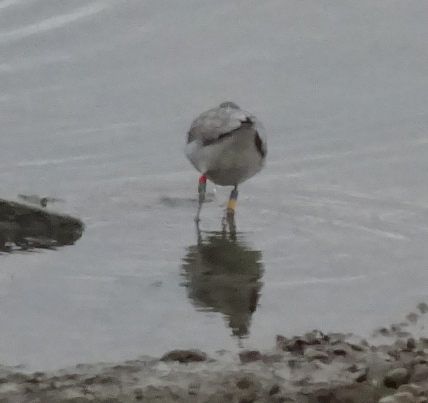
It has been a regular
winter visitor to Emsworth Harbour for the past 6
winters since it was ringed on 19-Mar-13 by Pete Potts
and his team on Thorney Island. It was one of the
birds fitted with a geolocator to track its movements,
but this was removed a couple of years ago. We are
still awaiting the results! Where exactly does it go
in the summer?
SATURDAY
JANUARY 19 - 2019
Farlington
Marshes
Nicola Hammond
reported this morning's walk by the Havant Wildlife
Group :
10 intrepid souls met at a chilly Farlington Marshes
for this week's wildlife walk. Photos from Derek
Mills.
From the western car park we viewed a flotilla of red
breasted mergansers led by a splendid male and around
50 ringed plover were well camouflaged on the sea wall
adjoining the road. We watched a large flock of
lapwing swirling above The Point and above Hayling
Island was, what we later decided, a very big flock of
dunlin. Better was yet to come!
We walked down to the lagoon where nice views were to
be had of fairly large groups of avocet, redshank,
pintail and shelduck. High tide was at 9.40 this
morning so we were fortunate to see a large number and
range of birds on the marshes, including widgeon,
teal, lapwings, shelduck, moorhen, scattered curlew,
some greenshank, black tailed godwits, little grebes,
shovellers, Brent and Canada geese and a lone Greylag
goose.
Shelduck
with mystery pale duck. What is
is?

Smaller birds included
starlings, stonechats, dunnock, pied wagtail and rock
pipits. From the Point area we viewed a small island
which was crammed with dunlin, grey plover and
a few black tailed godwits and oyster catchers.

Turnstones were doing
what turnstones do along the edges. Looking back we
had nice views of a marsh harrier skimming along the
top of the reeds.
We took a coffee break on the eastern side of the
point field where alongside was another very small
island populated by dunlin and grey plover. Suddenly a
glittering mass of birds came weaving and swirling
back and forth, all trying to cram onto the island as
well. They were Bar-tailed Godwits!
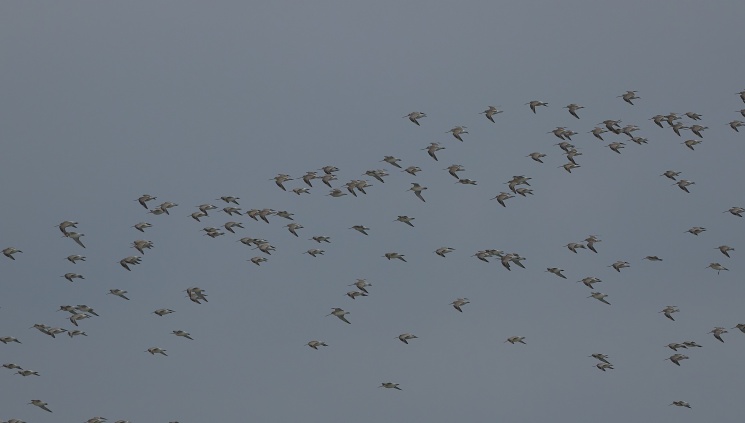
It was a wonderful
sight and we were also treated to large flocks of
lapwing giving aerial displays, assisted at times by
starlings. Heather also spotted a peregrine perched on
a post in the distance.
As we walked down the eastern sea wall we met a chap
doing a count of the Brents and he pointed out a
peregrine which was perched on the ground in the
marshes and also two ravens. We continued along the
path by the hut where we saw a kestrel and had more
excellent views of the marsh harrier. The final treat
was a reed bunting feeding on reed seeds, spotted by
Heather.
The shared eyes, knowledge and enthusiasm of everyone
attending always makes such a rewarding morning,
despite the weather!
For more information
about this local group which has a walk every Saturday
go to . . . Havant
Wildlife Group
FRIDAY
JANUARY 18 - 2019
Two
Egrets in garden
We often get
one Little Egret on the back wall of the garden
overlooking the Westbrook Stream but today there were
two, albeit too briefly for me to get a shot. However,
here is what I assume is our regular Egret which spent
much of the rest of the day, either on the fence
overlooking the stream, or on the roof of my
neighbour's shed. It looked very much at home
there!

Langstone
Mill Pond
Peter
Milinets-Raby had a high tide visit to Langstone Mill
Pond this morning from 9am to 10am. Chilly with plenty
of sunshine. Great for photos, however, not many birds
around.
173 Brent Geese, 74 Shelduck with another 39 in the
distance off Conigar Point, 9 Red Breasted merganser,
44 Wigeon, 18 Lapwing.

On the pond: 1 Canada
Goose (still lingering), 43 Teal.
In the horse paddock:
1 Oystercatcher, 2 Stock Dove. Light coloured Buzzard
perched on a post
THURSDAY
JANUARY 17 - 2019
Brook
Meadow
Work session
There was a
good turn out of 11 volunteers for this morning's work
session on Brook Meadow led by Maurice
Lillie.

The main jobs
involving raking and clear of cut vegetation finishing
with a bonfire.
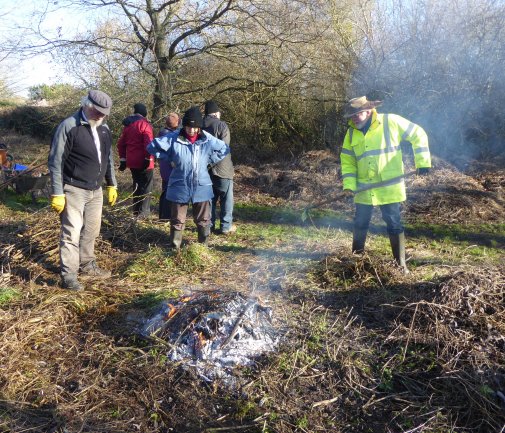
For the full report
and more photos go to . . . https://www.brookmeadow.org.uk/conservation-news/
Wildlife
As well as
taking photos and videos of the work, I spent some
time collecting a selection of winter twigs, including
Aspen, Black Poplar, Goat Willow, Crack Willow, Osier.
Hazel with yellow
catkins and Alder with dark red catkins and nascent
cones.
I also discovered a
rather poorly looking Ladybird (probably Harlequin) on
the Alder. It should be hibernating somewhere
warm.
'Golden
Willows'
Maurice
Lillie, David Minns and I stopped to admire the tall
'Golden Willows' in the western plantation and noted
how different they were to the standard Crack Willow,
having tall straight trunks topped with conspicuous
bright orange-yellow twigs glowing in the winter
sunshine. They were planted on Brook Meadow over 20
years ago by the Council to shield the gasholder (now
gone). There are some more at the end of Seagull Lane
and on the south side of Palmer's Road Copse.
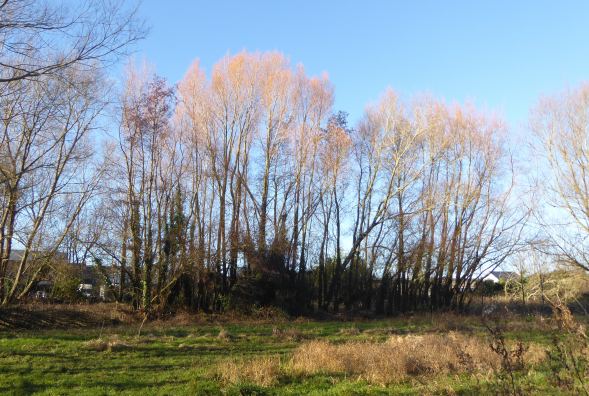
It was confirmed by
BSBI Recorder Martin Rand that these willows are
hybrids between the true Golden Willow (Salix
alba var. vitellina) and Crack Willow
(Salix fragilis) and are called Basford
Willows (Salix x rubens forma
basfordiana). They are characterised by
conspicuous orange-yellow twigs which glow in the
winter sunshine and very long pendulous yellow
catkins.
Views
It was such a
beautiful morning that I could not resist taking a few
more shots of notable features of Brook Meadow which
were looking good in the bright winter sunshine.
A view from the
north path looking towards the north bridge.
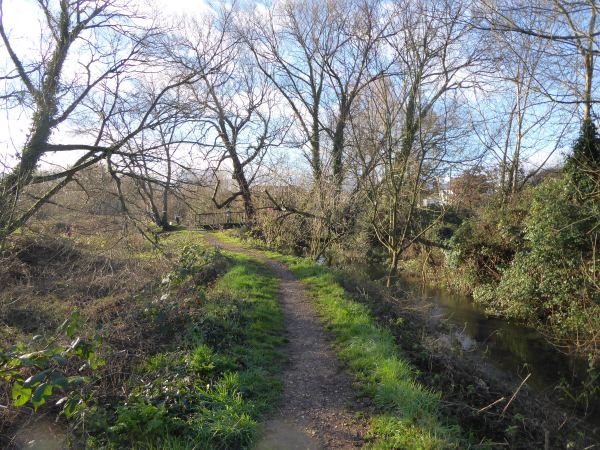
A view of the Aspen
tree looking south towards the centre meadow

A view of the two
Black Poplars which were cleared by volunteers
today.
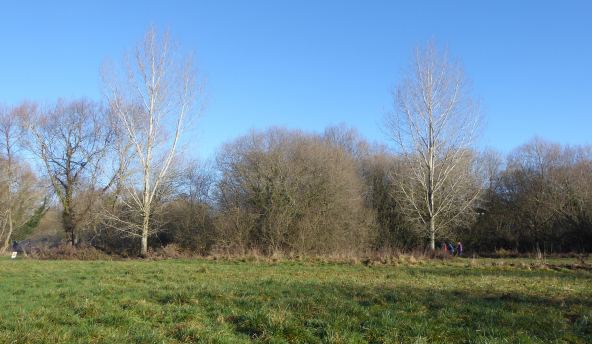
A view of the Lumley
Stream with a fallen Willow tree
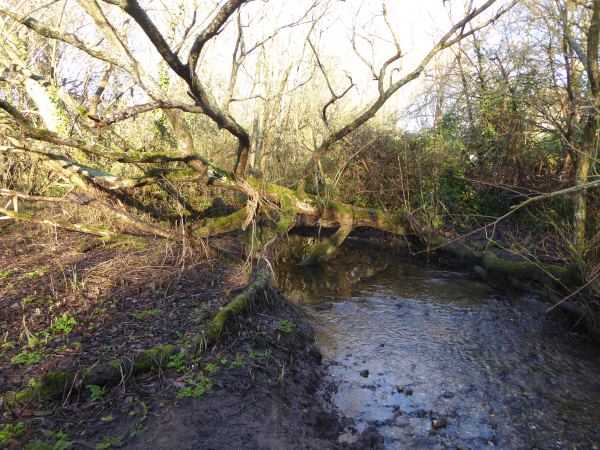
TUESDAY
JANUARY 15 - 2019
Langstone
Mill Pond
Peter
Milinets-Raby visited the Langstone Mill Pond this
morning for an hour from 9am - low tide. The birds of
interest were as follows:
On the pond: 1 Canada Goose (still lingering), 2 Mute
Swan, 12 Teal. 1 Chiffchaff heard calling.
Heronry news: 4 Grey Herons: Top Holm Oak nest
with two adults in pristine clean spring plumage and
one of the two birds was noted snuggling down with
lots of wiggles onto the nest (probably sitting on
eggs?). The lower Holm Oak nest had a pristine
plumaged adult stood over the nest. Nest 10 had a grey
drab bird on the nest moving sticks about. So that's
three nests nearly up and running.
Well, I did see my first Daffodils and Snowdrops
today!! . . . 'Spring is on the way'.

Off shore: 2
Greenshank (G//R +BR..-), 112 Teal, 74 Shelduck, 151
Dunlin, 12 Grey Plover, 1 male Pintail, 120+ Brent
Geese, 5 Red Breasted Merganser, 10 Wigeon, 1 Great
Crested Grebe, 9 Black-tailed Godwit.
MONDAY
JANUARY 14 - 2019
Warblington
shore
Peter
Milinets-Raby was out this morning and visited the
Warblington shore from 9am to 10:30pm. His report
follows . . .
The 2 Cattle Egrets,
with 3 Little Egrets were in the Ibis field for 10
minutes before they flew off north, much to the dismay
of the visiting birders. There were more aimlessly
wandering bird watchers than birds this morning! !
The birds of note were as follows: 1 Goldcrest in the
cemetery,
Ibis field: 1 Grey Wagtail, 2 Song Thrush, 16 Redwing
(without doubt the birds of the morning ), 1
Buzzard.
Conigar Point : 109 Wigeon, 124 Brent Geese, 14 Teal,
A pair of Pintail, 2 Grey Plover, 4 Shelduck.
Off Pook Lane : 95 Shelduck, 42 Wigeon, 1 Great
Crested Grebe, 9 Red breasted Merganser, 79 Teal, 307
Brent Geese, 4 Grey Plover, 24 Black tailed Godwit, 48
Dunlin, 1 Greenshank.
SUNDAY
JANUARY 13 - 2019
Emsworth
walk
I had a
pleasant walk this morning through Brook Meadow and
down to Peter Pond. I was pleased to spot a wintering
Chiffchaff working its way through the bushes
on the west bank of the river in Palmer's Road Copse,
the first sighting of the winter period. They are
almost certainly around, but not easy to find unless
they sing that is.
This Chiffchaff was much too active for a photo, so
here is a nice one from my files taken by Tony Wootton
at Titchfield Haven in December 2013.

I happened to meet
Roger Mills who told me he had seen the first blossom
on the Cherry Plum tree near the Lumley gate -
Roger is always the first to spot this early flowering
tree. I could only see one flower out when I looked
later, which I suppose is the one Roger saw too.
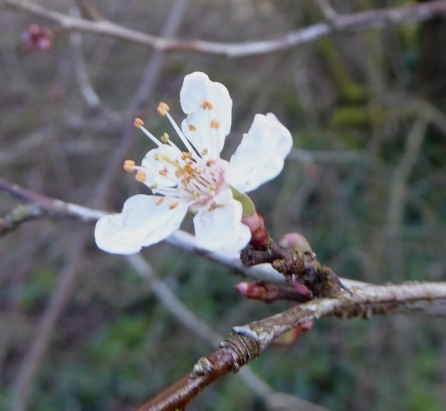
Three clumps of fresh
green leaves of Hairy Garlic (Allium
subhirsutum) are now showing well at the
eastern end of the footpath behind Lillywhite's
Garage. It gets its common name from the distinctive
hairy edges to its leaves. It also has a faint garlic
aroma when the leaves are crushes. Hopefully, we shall
see the pretty white star-like flowers in early spring
(March-April), though sometimes it does not seem to
flower at all, or maybe I just miss them.
The Mute Swan
family with 3 cygnets is still on Peter Pond,
though there was a clear indication that the cygnets
will all soon be driven off from their parent's
nesting territory. You can see the cob chasing one of
the cygnets in the background of this photo.

Garden
Egret
We had a
Little Egret on the wall at the end of our garden this
afternoon, looking down into the stream that runs at
the end of the garden. After a few minutes looking it
dropped down to the stream, to catch small fish that
live there.
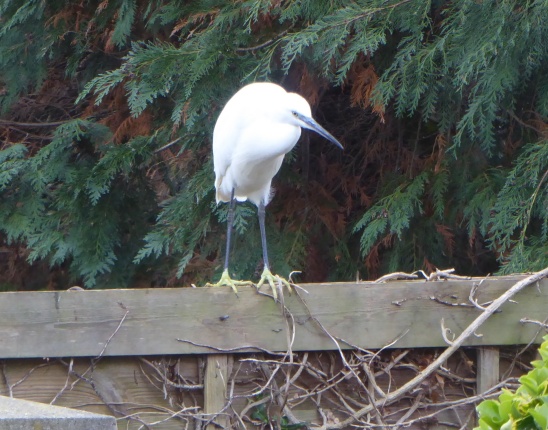
This elegant bird is a
fairly regular visitor to the garden, though rarely
actually comes onto the garden itself, usually
remaining on the end wall. However, this the first
time we have actually caught sight of the bird for
over a year, though we may well have missed it as it
does not tend to stay long. The following chart shows
the per cent of weeks the Egret was seen in the garden
each year since 1998.
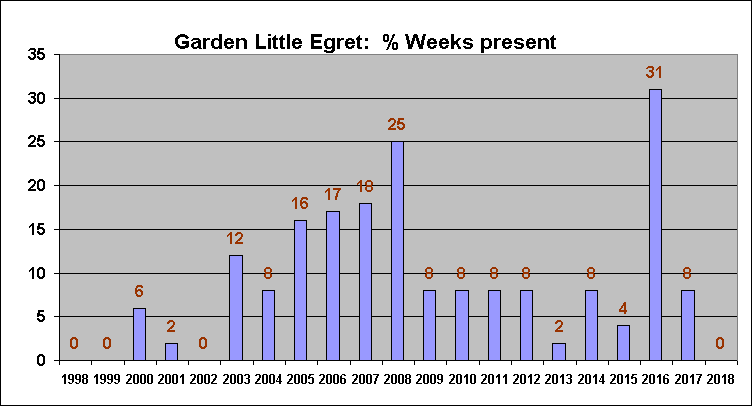
SATURDAY
JANUARY 12 - 2019
Redwings
Sue Thomas had
her first winter Redwing on a very berried tree this
afternoon. One of a flock of four. She was hoping for
waxwings but redwings are very welcome! Has anyone
else had them?
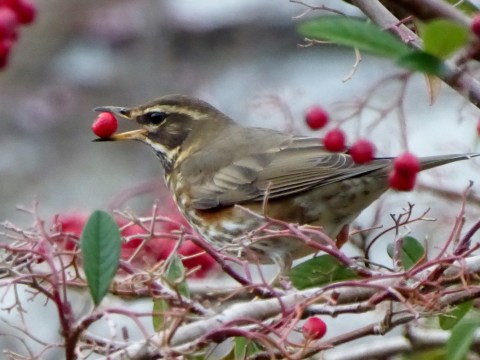
For a report of
today's walk by the Havant Wildlife Group at
Bosham
go to . . . http://familyfellows.com/hwg-walk-reports-2019.htm
FRIDAY
JANUARY 11 - 2019
Nore
Barn
I spent
another very enjoyable hour or so, from 11.30 to
12.30, at Nore Barn with the tide rising to high water
in about 2 hours. Much as yesterday, the conditions
were perfect for birdwatching, calm sea, no wind and
no sun. The bay crammed with hundreds of Brent Geese,
Wigeon and Teal with a flock of around 90 Black-tailed
Godwits feeding around the edges. Many of the birds
were pushed by the incoming tide into the creek south
of the woods where they were much easier to see.
The Kent-ringed Black-tailed Godwit with three rings
on each leg (ROL+RLR) that I saw yesterday was here
again along with another Emsworth Harbour regular
(G+WR) that I have seen no less than 126 times over
the past 10 years. It was originally caught and ringed
at Farlington Marshes by Pete Potts and his team on
10-Sep-08 as adult male.
On the left is
Black-tailed Godwit G+WR and on the right is G+WR
along with ROL+RLR
My best sighting of
the morning was of four Pintail, 2 males and 2
females, sailing serenely, as only Pintail can do,
through the myriad of geese and other ducks. Not a
very good photo, but they were a long way out.

As for the stream, it
was surprisingly empty of birds. When I arrived I
noted the regular colour-ringed Greenshank (G+GL) and
a couple of Black-tailed Godwits in the shallow water,
but no Spotted Redshank. When I got back from my
sojourn up the creek there was nothing in the stream
at all, no Spotted Redshank, nothing, even though the
conditions appeared to be perfect. But not to worry,
it does seem to like keeping us on our toes.
I was very pleased to
meet up with two of my old friends. Dave Thompson was
an inspirational leader of the Southbourne Sea Scouts
group when my son Danny was a member. He was pleased
to know that Danny's son Joe has also enrolled as a
cub at Southbourne. We swapped stories about birds. He
told me about a close encounter with a Sparrowhawk the
wings of which brushed his face as it chased down a
Woodpigeon. Both none the worse for their experience.
I also met up with
Dave Mead who I had not seen for many years. Dave was
the RSPB leader of walks and talks in Portsmouth for
many years and a very skilled and knowledgeable
birder. We had a chat about the local birds. I told
him to look out for our very colourful triple-ringed
Black-tailed Godwit.
THURSDAY
JANUARY 10 - 2019
Nore
Barn
I arrived at
Nore Barn at 11.30am with about 2 ½ to high water
and stayed for an hour as the tide gradually pushed in
- the perfect time for watching birds at this prime
local spot. When I got there the bay was simply
teeming with Brent Geese, Teal, Wigeon and
Black-tailed Godwits, their distinctive calls wafting
across the declining mudlfats. Although it was chilly,
the sea was calm and little wind and there was no sun
which helped with photography.
Encouraged by a report from Liz Cook who had e-mailed
me to say she saw a Spotted Redshank in the Nore Barn
stream yesterday afternoon, I made my way to the
stream which was filling up nicely. And, hey presto!
There it was - our famous Spotted Redshank which had
been giving some of us a little concern over its
recent absence. But no need to worry, it is back! Here
is my first photo of the bird plus a video clip of its
typical behaviour.
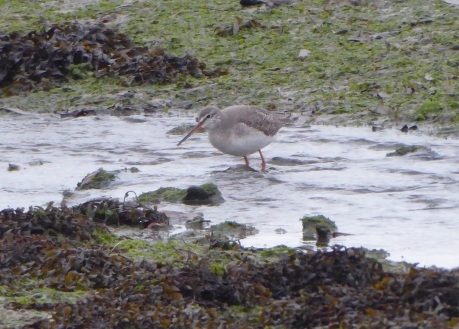
Video clip of the
Spotted Redshank in the Nore Barn stream . . .
https://youtu.be/tA0_O7G4-fY
Its feeding companion
the colour-ringed Greenshank (G+GL) was also present
in the stream and when I left about an hour later the
two of them were feeding together at the top of the
stream near the bridge. How fortunate we are in
Emsworth to be able to see such a fine pair of birds
at such close quarters. Incomparable!
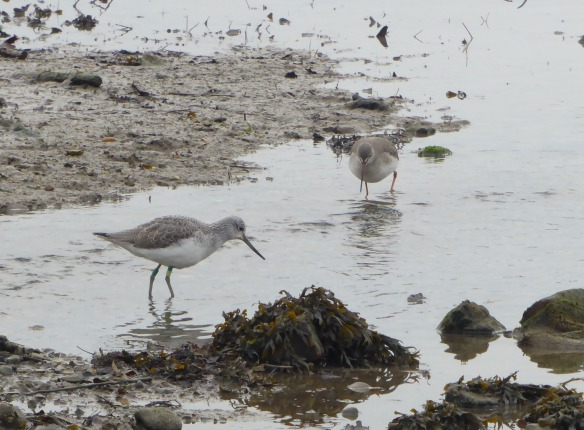
For the full history
of the Emsworth Spotted Redshank go to . . .
http://familyfellows.com/x-spotted-redshank.htm
I positioned myself on
the path south of the woods to watch the rising tide
push the Godwits, Brents and Teal into the creek. It
was from here that I spent a magical 30 mins or so
watching 50 or so Black-tailed Godwits furiously
jabbing their long bills beneath the water and into
the mud, rather like over sized Dunlin, usually coming
up with morsels of food.

The rather frenetic
feeding beahaviour is shown well in the following
video clip . . . https://youtu.be/EEyFq_0zUDg
Meanwhile flocks of
Brent Geese sailed serenely by and distant Teal
whistled to one another. Among the 100 or so Brent
Geese I counted 7 juveniles in families of 3, 2 and
two ones (I think) which is not bad for what has
clearly been a poor breeding season. Here is a photo
of one of the families of two adults and one juvenile.

I kept a look out for
any colour-ringed Black-tailed Godwits and spotted an
'old friend' with 3 coloured rings on each leg ROL+RLR
- unmissable! This bird has been visiting Emsworth
each winter for the past 10 years since it was first
ringed 27-Oct-08 at Kingsnorth Power Station, Medway
Est. Kent as an adult male. Astonishingly, this was my
106th sighting of this bird in Emsworth. I last
recorded it here on 06-Nov 2018.

WEDNESDAY
JANUARY 9 - 2019
Redshank
Following the
concern expressed by Peter Milinets-Raby over not
seeing the Spotted Redshank for a few days I nipped
into Nore Barn on the way home from my stewarding
stint at the Pallant Gallery to have a look for it. I
arrived at 1pm when the tide was almost full, not
ideal for seeing the Spotted Redshank. I could just
make out what was clearly a Redshank resting on the
edge of the saltmarshes. But was it the Spotted? I
studied it for some time with my bins, trying
desperately to turn it into a Spotted Redshank, but
but no luck. It was definitely a Common Redshank. I
managed to get a distant photo of the bird with my
Lumix on full zoom.
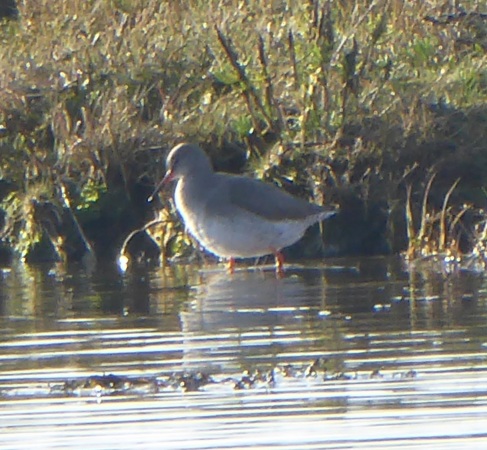
Warblington
shore
Peter
Milinets-Raby visited the Warblington shore this
morning and had an amazing close encounter with two
young Roe Deer bucks. He says . . .
I was
standing on the beach by the wall looking into the
SSSI field. Then out of the marsh grass bounded two
Roe Deer, coming directly towards me (As my head was
barely visible above the wall, the deer obviously
could not see me). They bounced up to the wall and
stopped to contemplate whether to jump it? They were
literally less than 20 feet away. It really did feel
as if they were about to leap, but suddenly they
noticed me and off they bounded back as quickly as
they came. It was three to four minutes of an
exhilarating wildlife encounter. I don't think I have
even been so close! (see photos). I think this is only
the third time (in six years) I have seen Roe Deer in
this area.

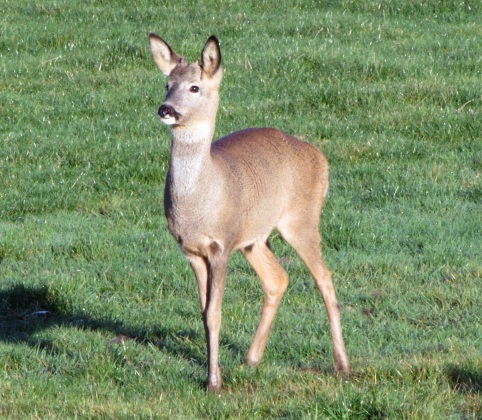
The rest of the
morning was dull in comparison (9am to 10:35am - low
tide).
Ibis Field: 2 Cattle
Egret and 1 Little Egret briefly before they flew
north towards their favourite field to the west of the
water cress bed. 6 female Pheasant, 1 Green
Woodpecker, 1 Oystercatcher. 11 Skylark in the big
field to the east of the Ibis Field
Conigar Point: 8 Grey
Plover, 6 Dunlin, 1 Red Breasted Merganser, 9
Shelduck, 4 Wigeon, 1 Greenshank.
Off Pook Lane: 183
Dunlin, 6 Grey Plover, 27 Shelduck, 15 Red Breasted
Merganser, 26 Wigeon, 63 Teal, 195 Brent Geese, 31
Black-tailed Godwit, 11 Lapwing. A pair of Pintail. 1
Great Crested Grebe.
Avocets
at Farlington
Mike Wells
spent two very cool hours walking around Farlington
Marshes this morning. Highlight was seeing approx 42
slumbering Avocets in the harbour just south of
Kendall's Wharf (Eastern Road).

Mike also sent photos
of Pintail, Lapwing and Wigeon.
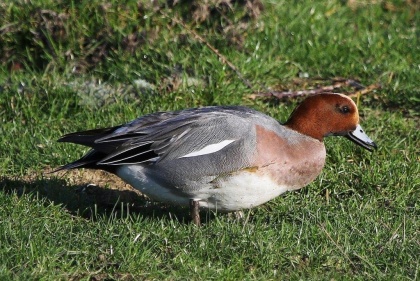
TUESDAY
JANUARY 8 - 2019
Emsworth
Harbour
This morning
Peter Milinets-Raby had a walk around Emsworth Harbour
and Nore Barn ahead of an incoming tide - 9am to noon.
Here is Peter's report . . .
At Nore Barn I bumped into Andy Johnson who was
counting people and dogs in connection to the Bird
Aware Solent group. It was his second day at the site.
The interesting information he parted, was that the
Spotted Redshank was not present yesterday and today
with 'ideal' conditions and 1 Redshank, 1 Greenshank
(the usual bird G//R + GL//-), 3 Black-tailed Godwit
and several Teal in the steam outflow, the Spotted
Redshank was again NOT present. What does this mean?
Where has it gone? Has a bird of prey or a even a dog
taken it?
The birds of interest from my walk this morning were
as follows:
Beacon Square: 152 Brent Geese, 63 Wigeon, 5 Teal, 21
Black-tailed Godwit, 2 Grey Plover.
Emsworth Harbour: 15 Turnstone, 159 Dunlin, 15 Grey
Plover, 578 Brent Geese, 7 Little Grebe, 4 Shelduck, 4
Sandwich Tern feeding with hefty plunge dives, 10
Black-tailed Godwit, 45 Teal, 6 Lapwing, 43 Coot with
29 Coot on the Mill pond with 2 Little Grebes, 2
Gadwall, 1 Black Swan by the sluice gate by the town
(see photo).

Nore Barn: 2 Grey
Plover, 76 Black-tailed Godwit, 5 Pintail, 279 Wigeon,
127 Teal, 27 Lapwing, 1 Greenshank (usual bird - G///R
+ GL//- What has he done with his friend?), 220+ Brent
Geese, 44 Shelduck, 1 Sandwich Tern (probably one of
the four from around the corner).
Brian's
note: re Spotted Redshank
I don't think we should be too worried about the
Spotted Redshank's absence at Nore Barn over the past
two days. I have found in past years that the bird
does disappear for several days running before making
a welcome reappearance.
However, I would be grateful for any sightings of the
bird over the next few days. The best time to look for
the bird is 2-3 hours before and after high water.
Tomorrow (Wed Jan 9) high tide is at 13.22 so look
from 11.00 onwards.
MONDAY
JANUARY 7 - 2019
Emsworth
Waxwings
I am grateful
to Colin Vanner for letting me have this fine image of
one of the Waxwings that turned up in the garden of
the Sussex Brewery in Emsworth last Friday (Jan 4). I
trust Colin enjoyed a pint of best to celebrate. Are
they still there?
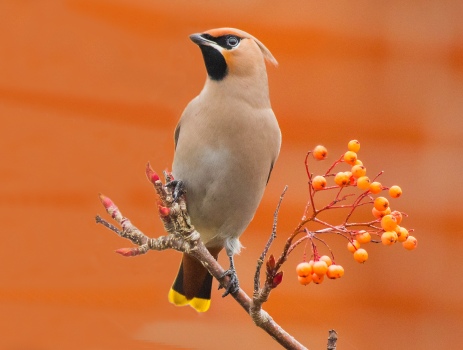
Prinsted Fox
Romney Turner
went for a walk at Prinsted and got a couple of fine
images of a Red Fox sunning itself down a bank. Romney
says the Fox was not in the slightest bit worried
about her being up on the bank and had a good yawn
showing me a good set of teeth!

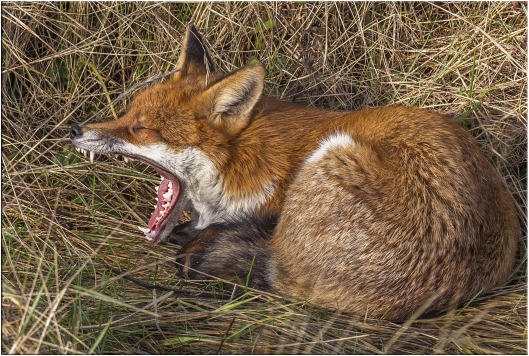
SUNDAY
JANUARY 6 - 2019
Brook
Meadow Work session
It was a cold
and dull morning, so I wrapped up well for the work
session on Brook Meadow at the new earlier start time
of 9.30. There was a good turn out of 12 people led by
Colin Brotherston who outlined the main tasks to be
carried out.

Main job was to make a
bonfire to burn up twigs and small branches that have
been left from earlier work sessions. Everyone loved
the bonfire, as did I.

For the full report
plus more photos and video go to . . .
https://www.brookmeadow.org.uk/conservation-news/
Video clip . . .
https://www.youtube.com/watch?v=l9GbnBu2aBo
Peter
Pond
I had a stroll
down to Peter Pond where I found David Gattrell busy
digging out the channel on the east side of Peter
Pond. He's doing a fine job.
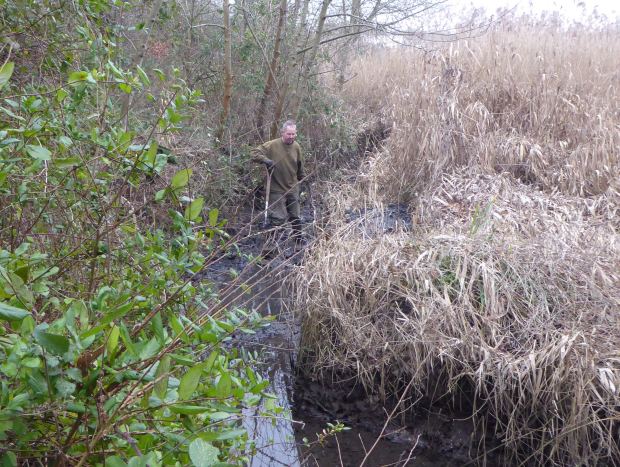
David tells me he saw
Elisabeth Kinloch before Christmas. Elisabeth is the
owner of Peter Pond and was an early member of the
Brook Meadow Conservation Group committee. Sadly, she
now suffers from dementia and has full time care in
her Westbourne home. We send her our best wishes.
Wildlife
observations
Bird song on
Brook Meadow included Robin prominent as usual, plus a
Wren on the river bank and a splendid Blackbird near
the Lumley gate. I also heard a Woodpigeon song for
the first time. This Robin took advantage of the
clearance work done by volunteers to explore for
wintering insects.

The Alder sapling near
the Lumley Stream is adorned with purplish catkins and
old knarled cones from last year.
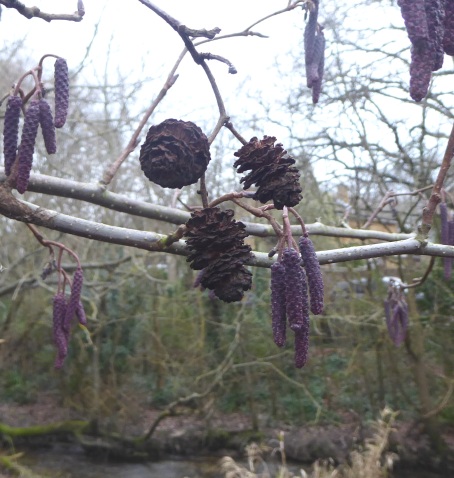
Dan told me about a
male Blackcap that had stunned itself by flying into
his patio window. Fortunately it recovered and flew
off. This will be one of the wintering population of
Blackcaps that visit the UK from the Continent and
feed mainly in gardens. They are a different
population Blackcaps from the summer visitors which
migrate here from Africa in the spring.
Waxwings
No more
sightings of Waxwings in Emsworth today, though the
local news reported that about a dozen of these
attractive birds had been spotted in red berried trees
in the Asda car park at Totton near Southampton where
birdwatchers were assembling to see them.
SATURDAY
JANUARY 5 - 2019
Waxwings
hunt
Peter
Milinets-Raby went looking for Waxwings that were
reported yesterday in the garden of the Sussex Brewery
pub just over the county border in West Sussex. The
birds were not present though other birders present
said they had flown west. So, Peter scoured the
streets of Emsworth in Hampshire for the next hour
visiting all the pink berry bushes he could remember.
He did not find them, but is sure they are in Emsworth
somewhere, so please keep a look out for them and let
me know of any sighting.
Winter
Red Admiral
Yesterday,
Mike Wells had the welcome sight of a Red Admiral
sunning itself on ivy in his Waterlooville garden with
a temperature of just over 2 degrees! Although most of
these beautiful and resourceful insects perish with
the onset of winter, an increasing number are managing
to survive in warmer areas. Locally, I have often see
one fluttering around the Nore Barn Woods area in mid
winter.

FRIDAY
JANUARY 4 - 2019
Waxwings
in Emsworth
Ralph Hollins
alerted me to the report of 4 Waxwings seen today in
the Sussex Brewery car park by L. M. Fuller from 13:50
to 15:30. Report on the HOS Sightings page at . . .
https://www.goingbirding.co.uk/hants/birdnews.asp
Ralph added that in the past few days Waxwings have
been reported at several south coast sites (including
Totton, Plymouth, and Kingley Vale). So keep a look
out for them on the red berried trees.
No local photos
yet, but here's one from our old friend Richard
Somerscocks in Scotland to whet your appetites

Black
Swans over Thorney
Christopher
Evans saw two Black Swans flying over by the sluice
gates on the east side of Thorney. He also got a brief
glimpse of the regular Kingfisher and a Fox with what
could be someone's lunch. No Owls today.
Avocets
at Nutbourne
Sue Thomas
enjoyed a flock of 28 Avocets on a beautiful winter
morning at Nutbourne at the bottom of the Farm Lane
footpath. Sue managed to get a group of 5. She was
also pleased to see a small flock of 3 Yellowhammers.
THURSDAY
JANUARY 3 - 2019
Winter
Hedgehog
Joyce Sawyer
reports that two nights running she has seen a
Hedgehog in her garden in Denvilles. The photo shows
the hog with its eyes closed but Joyce says it is very
much alive as it had been eating cat food at the hog
feeding station and was just enjoying a drink to wash
it down.

Brian's
note: Joyce's
Hedgehog does not look very well to me, as if it wants
to go to sleep, but is not in a suitable place. Seeing
a Hedgehog outside in winter is not good as they
really should be hibernating.
The Hedgehog guide at . . . http://www.thehedgehog.co.uk
. . . says that with our warmer winters many Hedgehogs
are not going into hibernation until well into
January, so this might be the case for Joyce's animal.
However, if the weather turns really cold (like it did
last year with the 'beast from the east') then they
need to find somewhere warm and cosy to hibernate
otherwise it is curtains. Putting food and water down
all the time is recommended.
Caroline
French replies: Although
we would expect hedgehogs to be hibernating at this
time of year, they can and do emerge to seek food,
especially during mild periods. There is evidence of
one being around in my garden recently. As Brian says,
it is good to leave out some suitable food (eg dried
cat food or a bespoke hedgehog food ) if possible in
case a hungry hedgehog is in need of it. Fresh water
is also really important.
It's not clear from the email whether this animal's
eyes are permanently closed or just closed in the
photo. If closed all the time I would suggest
contacting Brent Lodge Wildlife Hospital for advice.
The same applies if it is seen out during the
daytime.
Hopefully though, this animal is just taking the
opportunity to feed up a bit. Good to know they are
still around the Denvilles area.
Other good sources of advice are the Hedgehog Street
website and the British Hedgehog Preservation
Society.
Let's hope s/he makes it through the winter to breed
successfully next spring. If enough of us do our bit
to help by providing food and suitable nesting and
hibernating habitat we may be able to stem their
decline.
Barrie's
news
Barrie Jay
reports it has been a very quiet winter, bird wise, so
far in his Waterlooville garden, though he has had a
couple of Song Thrushes. Lucky old Barrie, I have not
seen one of those in my garden all year.
Today Barrie went to Lee on The Solent and on the
fence of the Airport he spotted a female Black
Redstart and got a distant shot of it. Barrie also
got this fine image of a Meadow Pipit along the
Promenade.
But most astonishing
was Barrie's photo of four Red Kites taken at
Popham Airfield near Basingstoke where he said there
are now 8 resident Red Kites. Barrie regularly sees
one in the sky over West Waterlooville and thinks it
can only be a matter of time before these magnificent
birds will become common over our skies in the South!
Now, that is a nice thought to start the New Year
with.
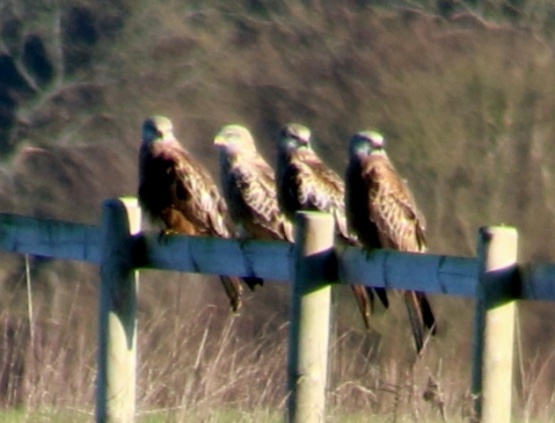
Warblington
shore
Peter
Milinets-Raby was out on the 1st of Jan for a quick
wander around Warblington and the shore. He managed 65
species: The highlights were:
2 Cattle Egrets and 3 Little Egrets in the Ibis
Field until the farmer unavoidably flushed them when
he came and fed the cows
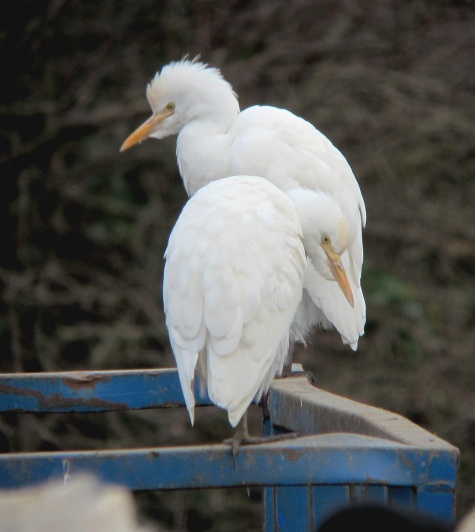
Off Pook Lane: 350
Brent Geese, 13 Black-tailed Godwit, 10 Grey Plover,
an impressive flock of 400+ Dunlin, A pair of
Goldeneye, 1 Greenshank, 1 Great Crested Grebe. 1
Sparrowhawk, 2 Buzzard, 5 Lapwing.
A pair of Grey Herons together on the Number One Holm
Oak nest looking very lovey dovey. 1 Canada Goose on
the Langstone Mill Pond. 2 Mute Swan.
Peter's
report of 2018 Birds of Emsworth & Warblington
An end of year
summary of the Birds of Warblington & Emsworth in
2018: A personal review by Peter Milinets-Raby
The total number of
species for the area is currently 179. There were just
two additions to the list in 2018, these were Egyptian
Goose and Black-throated Diver. My personal list for
the area stands at 153. I managed 118 species this
year, which is about the norm for the last six years.
Below is an abridged review of the key species of the
area.
Shelduck:
A new maxima count for this species was achieved on
December 14th when 109 were present along the
Sweare channel surpassing the January 2017 record of
103.
Egyptian Goose:
The first of just two new species to the area was a
flock of six Egyptian Geese that were observed
heading north inland over the Warblington castle tower
on December 11th.
Mandarin Duck:
There were two sightings of this species this year
bringing the total of sightings for the last six years
to just four. The first was of two female/eclipse
types on Langstone Mill Pond on August 29th and the
second sighting was of a female also on the Langstone
Mill Pond on September 17th.
Teal:
A male was present on Langstone Mill Pond in the
middle of summer on June 4th. This was a truly
unprecedented observation as normally the months of
May and June have zero records.
Pintail:
An indifferent year with numbers down on 2017, with
14 being the highest count seen at Nore Barn
during March.
Goosander:
The Juvenile/female discovered in November 2017 was
still around on Emsworth Mill Pond on January 1st and
again on 7th. In the late year on November 26th a
female with four juveniles was observed feeding in the
stream outflow by Emsworth town wall.

Black-throated
Diver:
The second new species for the area with one seen at
high tide diving very close to the Langstone Mill Pond
on January 2nd.
Cormorant:
An amazing fishing flock of 36 birds was
observed off Conigar Point on November 23rd. This is
over double the best count over the last six
years.
Little Egret:
I hope this year was a one off and not the start of a
downward trend. It was, in truth, a disastrous year
with breeding numbers at Langstone Mill Pond down by
50%. The first signs of breeding were noted on April
10th when a pair were displaying in the Holm Oak and
loitering by an old nest. The colony blossomed three
days later, with nineteen birds present in the colony
with ten nests occupied! On April 19th there were 22
occupied nests with three of them on the island.
Things then, inexplicably slowed down and by April
23rd only one nest was occupied on the island and
around 20/23 nests were occupied in the main colony.
Alas, by May 10th the nest on the island had been
abandoned, leaving roughly 20 to 23 occupied nests,
which was 50% down on last year! The first chicks were
noted on May 24th, with at least four nests occupied
and by June 1st at least 11 nests held young. On June
12th I counted 31 juveniles in the colony. The annual
autumn roost count on August 29th produced only
136 egrets flying into roost (down by an
average of 50+ birds of the last few years). I wonder
what 2019 will bring. Will the colony return to its
glory days or is this the start of a disquieting
downhill trend?
Cattle Egret:
One was observed in the cattle fields around
Warblington on eleven dates from January 1st until
February 22nd. The onset of snow probably moved it on.
Almost certainly the same bird was seen in the flooded
horse paddock north of Langstone Mill Pond on January
5th. In the late winter period a Cattle Egret was
discovered in late November. It was a very elusive
bird, associating with a small group of Little Egrets
in the very muddy private cattle field west of the
Warblington cress beds and was noted on two dates from
November 21st until December 3rd. On this date it was
joined by a second bird and the pair continued to be
elusive until the year's end with just five further
sightings.

Grey Heron:
At Langstone Mill Pond there were 11 confirmed pairs
(one pair bred twice). Only the success of eight of
them was known. There were 19 young successfully
reared. Brief details of each are found below.
Nest 1: Top of Holm Oak:
The pair were observed mating on the nest on January
2nd 2018 suggesting that the earlier attempt at
breeding in November 2017 had failed? Confirmation of
breeding occurred on February 9th when an adult bird
flew in and started to regurgitate food items into the
nest. The other adult stood up and the faint sound of
chicks could be heard. Three grown young noted on
March 16th, which were getting ready to fledge, with
wing flapping observed. A single juvenile of the
second brood was noted on July 17th and two fully
grown young noted still on the nest on August 14th.
This pair have always managed a second brood in every
year they have bred.
Nest 2: Lower down the southern edge of the
Holm Oak:
An adult was observed sat on the nest on January 18th.
Two juveniles were observed standing on the nest on
April 9th.
Nest 3: South of the Holm Oak, obscured and to
the rear, in the lower branches of tall tree: Not
used.
Nest 4: In between Nest 3 and the Holm Oak, at
the rear, high up in a slightly taller Holm Oak. Two
adults were observed on the nest on January 5th and an
adult was sitting tight on the nest on 27th. Alas, a
Magpie was observed eating something on this nest on
February 21st (probably eggs). Thankfully an adult was
back sitting on the nest on March 8th. Two tiny young
were noted on May 10th.
Nest 5: About 1.5 metres south from Nest 3: Two
birds were standing on this nest on January 5th. Two
young were observed on this nest on April 28th.
Nest 6: In front and slightly below Nest 3: Not
occupied.
Nest 7: At the back of the main stand of trees
and to the south of all the other nests: This nest was
destroyed by the storms and re-built very quickly and
took shape by March 16th. Three young were confirmed
on May 25th.
Nest 8: At the rear of the Holm Oak, just below
Nest 1: An adult was observed sitting on this nest on
March 27th. It was very difficult to view this nest.
On April 21st a small juvenile was seen being fed by
an adult. And confirmed as just one on May 25th.
Nest 9: Now the furthest nest to the south of
the colony: On January 27th an adult was observed
sitting tight on the nest, with just its forehead and
bill sticking out - on eggs no doubt. Two adults were
noted feeding young on March 8th (just movement, no
numbers noted and no further sightings).
Nest 10: At great height, in-between the two
Holm Oaks: This nest was totally blown away by the
storms in late February, with not a single stick
remaining. It was rebuilt in six days in early March
and by 14th an adult was firmly sat on the nest. On
May 8th two juveniles were confirmed.
Nest 11: The other Holm Oak (above and slightly
to the left of Nest 4): On March 8th an adult was
sitting tight on this nest. Alas the nest was obscured
by foliage by April 9th and no further sightings were
made.
Nest 12: Above nest 9 and slightly below and to
the left of nest 7: Built up in the first week of
April and had an adult sitting on it on April 9th.
Three young observed on May 25th.
Nest 13: At the rear of the Holm Oak, below
Nest 1, but further away from Nest 8 at the very rear:
A new nest under construction on March 27th with an
adult bringing sticks in on quite a regular basis. An
adult was sitting on the nest on April 9th. Alas there
were no further sightings because of the foliage
cover.
Osprey:
There was just the one sighting this year on September
17th when a bird was seen circling over Brook Meadow
for a few minutes before it drifted off south towards
Thorney Island.
Hen Harrier:
The only sighting of the year was of a ringtail
heading west along Emsworth Harbour on October
28th.
Hobby:
There was only one record this year, bringing the
total number of sightings of the last six years to
just eight. On May 12th a single bird flew south over
the SSSI field at Pook Lane before it headed further
south across the Sweare Deep to Hayling
Island.
Avocet:
There were four sightings of this emblematic bird. Two
were feeding on the low tide mud off Pook Lane on
March 4th, 5th and again on 8th. And in the late
winter period three were seen along the low tide line
off Pook Lane on December 17th.
Ringed Plover:
There were three birds observed with colour rings. The
details are - on Peter's web site address at the end
of summary.
Golden Plover:
Another poor year with just four sightings. Where have
the large winter flocks gone? Four were present on the
low tide mud off Pook Lane on February 9th. After
light snow on March 18th, two flocks were noted moving
due to the cold weather - 24 east at Conigar Point and
29 north over Pook Lane. In the late winter period
five birds were on the muddy shore of Pook Lane on
December 11th.
Snipe:
The average number of sightings of this species per
year over the last six years is three. With just one
record in 2018, it was thus a relatively poor year.
The only record was on March 18th, after light snow,
of a bird heard calling as it flew over the
Warblington cemetery.
Knot:
There were no large flocks encountered, just a handful
of records and nothing above 20!
Black-tailed
Godwit:
Not as regular as previous years, with numbers
generally down, however a record count of 381
was achieved at Pook Lane on August 29th. There were
seven colour ringed birds seen throughout the year.
See details on Peter's web site address at the end of
summary.
Bar-tailed Godwit:
A very poor early winter period with 47 being
the maximum count on March 4th off Pook Lane. In the
late winter period sightings were again sporadic,
however large numbers did briefly occur along the Pook
Lane shoreline during mid-November with 126 on 9th, 58
on 14th and 104 on 19th.
Greenshank:
A new maxima for the month of August was set with
16 birds together in Emsworth Harbour. There
were 19 colour ringed birds noted this year See
details on Peter's web site address at the end of
summary.
Common Sandpiper:
Over the last six years this species is only ever
recorded once or twice a year, so this year was no
exception with one record. A juvenile was in the
Langstone Mill Pond outflow stream on August 28th.
Redshank:
There were 18 different colour ringed birds noted in
2018 (See details on Peter's web site address at the
end of summary.
Spotted Redshank:
A second bird briefly joined the usual long stayer at
Nore Barn on January 18th.
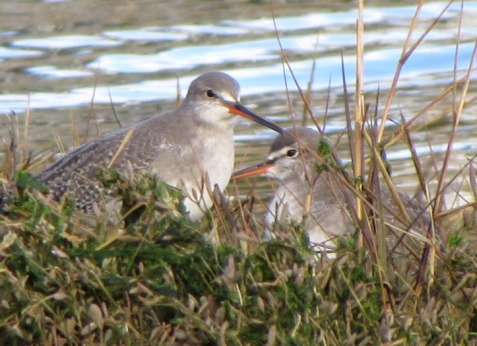
Water Pipit:
There were three records. One was feeding in the
rotting hay mound in the fields east of Castle Farm on
January 7th, with two there on February 11th. And
finally one was observed in the flooded horse paddock
north of Langstone Mill Pond on January 10th.
Stonechat:
A typical year with a couple of records. One was in
the SSSI field at Conigar Point on September 25th and
two males were active along the main hedge at Pook
Lane on October 10th.
Wheatear:
The only two sightings of this species were both in
autumn. The first was a bird along the shore at
Conigar Point on August 29th, with the second also
seen at Conigar Point on September 28th.
Firecrest:
One was seen briefly at Langstone Mill Pond on January
18th. Four were in Nore Barn Wood on January 25th,
with one noted there on February 18th.
Spotted
Flycatcher:
One typical autumnal record of a single bird in the
main hedgerow at Warblington on August 4th.
Bullfinch:
A female was seen at Langstone Mill Pond on November
5th. This is only the fourth record of this enigmatic
species in the last six years.
Yellowhammer:
On March 18th after a light sprinkling of snow, a
splendid male Yellowhammer was found feeding on the
main seawall path by Pook Lane, giving exceptional
views and photo opportunities for twenty minutes or so
before a dog walker with two dogs flushed it and I
could not re-find it. This is a new addition to my
patch list and a species that I did not think would
ever return. The species was a relatively regular
breeder in the area up to the turn of the century, but
there have been no records since the spring of
2003!
Reed Bunting:
A poor season with no suspected breeding at Langstone
Mill Pond. A handful of sightings of a male
half-heartedly singing during the first two weeks of
April, but nothing beyond 21st.
For details of the
colour ringed birds and photos go to Peter's web page
. . . https://peterspurplepages.wordpress.com/
For
the previous entries go to . . December
1-31